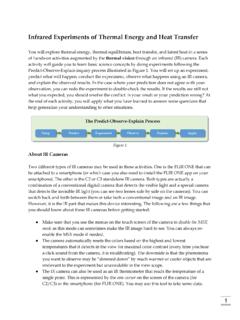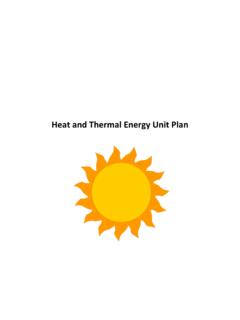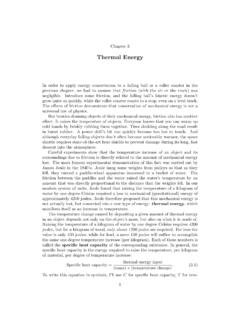Transcription of Lab Handout Lab 15. Thermal Energy and Specific Heat
1 Lab HandoutLab 15. Thermal Energy and Specific HeatWhich Material Has the Greatest Specific heat ? IntroductionScientists are able to identify unknown substances based on their chemical and physical properties. A substance is a type of matter with a Specific composition and Specific prop-erties. One physical property of a substance is the amount of Energy it will absorb per unit of mass. This property is called Specific heat (s). Specific heat is the amount of Energy , mea-sured in joules, that is needed to raise the temperature of 1 gram of the substance 1 degree Celsius. Scientists often need to know the Specific heat of different substances when they attempt to track how Energy moves into, out of, and within a system.
2 Chemists use a technique called calorimetry to determine the Specific heat of a substance. Calorimetry, or the measurement of heat transfer, is based on the law of conservation of Energy . This law states that Energy is not created nor destroyed; it is only converted from one form to another. This fundamental law serves as the foundation for all the research that is done in the field of thermodynamics, which is the study of heat , temperature, and heat transfer. heat is defined as the total kinetic Energy of all the atoms or molecules that make up a substance. Temperature, in contrast, is defined as a measure of the average kinetic Energy of the atoms or molecules that make up a substance.
3 heat , or Thermal Energy , can be transferred through a substance and between two dif-ferent objects. Scientists call this process conduction (see Figure ). The transfer of heat Energy through the process of conduction can be explained by thinking of the heat from a source causing the atoms of a substance to vibrate faster, which means they have greater kinetic Energy . These atoms then cause the atoms next to them to vibrate faster by bumping into them, which means that the kinetic Energy of the neighboring atoms increases as well. Over time, kinetic Energy is transferred from one atom to the next.
4 As more atoms in the substance gain kinetic Energy over time, the temperature of the substance increases. This process is also how heat Energy is able to transfer between two different objects that are in contact with each other. The amount of heat (q) transferred to an object depends on three factors. The first is the mass (m) of the object. The second factor is the Specific heat (s) value of object. This is important because an object will consist of a Specific type of substance, and each type of substance has a unique Specific heat value. The third factor is the resulting temperature change ( T).
5 The mathematical relationship between these three factors and the amount of heat transferred to an object isq = m s TThe materials that people use to build a new structure or to manufacture commercial goods have a wide range of Specific heat values. Take concrete and wood as an example. Both of these materials can be used to build benches in parks or at bus stops for people to use. Wood, however, has a much higher Specific heat than concrete. It therefore takes more heat Energy to increase the temperature of a 10 kg piece of wood than it does to increase the temperature of a 10 kg piece of concrete.
6 The piece of concrete, as a result, will get hotter faster than the piece of wood when it is exposed to the same amount of heat Energy . This issue could be a potential problem in cities that tend to be hot and sunny most of the year. Engineers and manufacturers therefore need to know how to look up or determine the Specific heat value of a potential building or manufacturing material before they decide to use it. In this investigation, you will have an opportunity to learn how to determine the Specific heat value of a material using the process of Task Use what you know about heat , temperature, the conservation of Energy , and defining systems to design and carry out an investigation to determine the Specific heat values of several different materials.
7 The guiding question of this investigation is, Which material has the greatest Specific heat ?FIGURE Energy can transfer through a substance or from one substance to another by conduction. A flame is applied to a metal heat energizes the atoms and they begin to vibrate vibration spreads throughout the metal may use any of the following materials during your investigation:Samples Aluminum (Al) Copper (Cu) Tin (Sn) Zinc (Zn) Glass Plastic WoodConsumables Water (in squirt bottle)Equipment Graduated cylinder (100 ml) 2 Beakers (each 250 ml) 2 Polystyrene cups Ring clamp and support stand Thermometer or temperature probe Hot plate Electronic or triple beam balance Tongs Stirring rod Safety glasses or goggles Chemical-resistant apron Nonlatex glovesSafety PrecautionsFollow all normal lab safety rules.
8 In addition, take the following safety precautions:1. Wear sanitized indirectly vented chemical-splash goggles and chemical-resistant nonlatex gloves and aprons during lab setup, hands-on activity, and Use caution when working with hot plates, because they can burn skin and cause Hot plates also need to be kept away from water and other Use only GFCI-protected electrical receptacles for hot Clean up any spilled liquid immediately to avoid a slip or fall Handle all glassware with Handle glass thermometers with care. They are fragile and can break, causing a sharp hazard that can cut or puncture Wash hands with soap and water after completing the lab Proposal Required?
9 Yes NoGetting StartedTo calculate the Specific heat of a material, you will need to determine how much Energy the material is able to transfer to a sample of water using a calorimeter. A calorimeter is used to prevent heat loss to the surroundings (see Figure ). The heat gained by the water in a calorimeter is therefore equal in magnitude (but opposite in sign) to the heat lost by the material:qwater = qmaterialThe amount of heat gained by the water is calculated using the mass of water used, the Specific heat of water ( J/g C), and the difference between the final and initial temperature of the water in the calorimeter.
10 The amount of water used for calorimetry varies, but most people use between 10 and 50 ml because water has such a high Specific heat . The equation for calculating the amount of heat gained by the water is qwater = mwater swater TwaterThe amount of heat lost by a material once it is added to the water is calculated using the mass of the material, the Specific heat of that material, and the difference between the material s final temperature and its initial temperature. The final tempera-ture of the material is assumed to be the same as the final temperature of the water in the cup. The initial temperature of the material will be 100 C.



















